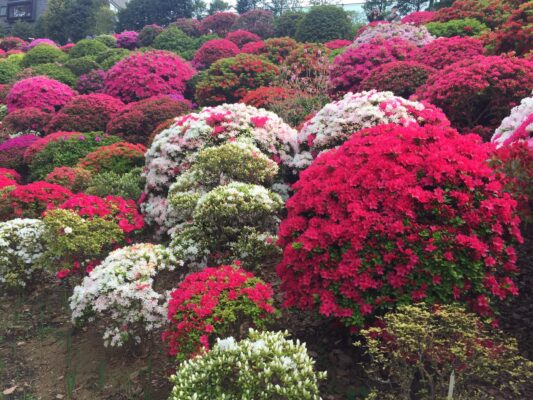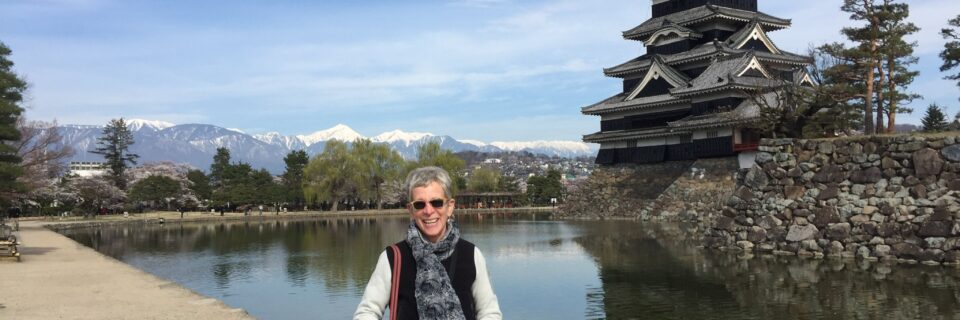We spend three days in Kyoto, an exciting city teeming with life and energy, streets crowded with residents and visitors hurrying in every direction. We visit famous temples, palaces, and gardens. Loveliest, though, is the Philosopher’s Walk, a two km path running alongside a canal lined with cherry trees in full bloom and so named for a famous Japanese philosopher who reputedly did his most creative thinking while taking his morning constitutional here.

Most memorable, however, is a tea ceremony demonstration at the tea house of a Swiss expat master tea maker named Michael.

Who knew there could be a four-hour ritual over a cup of tea? There are strict rules governing the entire procedure, including the invitation, how many people can attend, the size of the room, where the attendees must sit, where the teapot is placed, how the tea is stirred, which is the front as distinguished from the back of the tea bowl (note: never called cup), what is the meaning of a scroll in an alcove, whether there is a vase, and if so, what is the significance of the flowers placed in it, when conversation is permitted, or not, what are allowable subjects, how and at what point the invitees must depart. Michael is a great story teller, and answers our many curious questions with humor and wit. It is such fun and although we are at the tea house crouching on our knees (the required position) for several hours, we are sorry to leave. That’s the thing about travel- you never know when a window to an entirely unexpected experience will open up.
Then it’s on to the five day Kiso Road Walk between Nagoya and Matsumoto. This walk is a portion of the much lengthier Nakasendo Way that stretches from Kyoto to Tokyo and served, as far back as the seventh century, as a postal route connecting a series of rural villages offering teahouses, inns, and porter services. We stay at a series of these inns. The first has been operating by the same family continuously for more than four hundred years, now in its sixteenth generation! The second, in business for two hundred and fifty years and in its ninth generation of innkeepers, is more rustic with paper-thin sliding panels separating the rooms, and futons for sleeping barely above the tatami mat-covered floor.
Before dinner at the second place, we go to a public onsen, a communal bath fed by natural hot springs. The five men (including our guide) go to the men’s baths; the eight women to the women’s. Here there are rules, too. You’re not allowed in if you have a tattoo. Who enforces this I haven’t a clue. Everyone gets naked, sits on stools, lathers up and rinses off. The rule is you can never get into the onsen without having done so. Then you soak in the 107 degree water until your fingers get all pruney and you can’t take the heat anymore. You dry off and, feeling wonderfully infused with the heat of the bath, put on your yukata (a kimono with a sash and jacket), and head back to the ryokan thoroughly relaxed and ready for your tasty dinner of fresh local fish, vegetables, rice, and various styles of tofu.

The third night is spent at a three hundred year old establishment in its fourteenth generation of family operation. There is definitely a pattern in longevity of ryokan proprietorship.
On the fourth day of the Walk, we visit a comb museum. I mean a comb museum, really! It is fascinating. Comb-making is a traditional craft of Nagano Prefecture. We watch an expert craftsman with forty years experience as he sits cross-legged, bent over his special tools, working with precision and focus to create wooden combs out of birch trees that are so hard, they’ve been called “ax-breaking birch.”

The combs are extremely fine-toothed and don’t cause electricity while one is combing ones hair. I give consideration to buying one but I haven’t used a comb in twenty years!
I would be remiss if I I did not mention toilets in Japan. They are indeed a wonder. It is hard to keep track of all the bells and whistles. And these fancy devices are everywhere-hotels, museums, restaurants, train stations, convenience stores. There are various mechanisms for washing and drying your bottom. It’s helpful that there are pictures on the side of the toilet that show what each function is because the directions are written in Japanese characters. On some of them, as soon as you sit down, sounds of birds and the ocean are heard, apparently to mask unwanted noise.

But the main attraction from my viewpoint is that the seat is heated! I can’t say enough about this feature, especially on a cold morning at 5:00 am. I definitely plan to look into buying one when I’m back in Oakland in my very cold house.
After visiting Matsumoto Castle, the oldest intact castle in Japan (featured photo), we take a shinkansen (bullet train) to Tokyo, where we spend the last three days of our journey. On the train, we see the tall, snow-covered Japanese Alps and get a fleeting view of Mt. Fuji in the distance, cloud-enshrouded except for its snowy cone.
Tokyo has thirteen million residents. Each day, twenty million commute into the city, mostly by train, making the population swell to a total of thirty-seven million. This is evident when you try to negotiate the sidewalks. Eighty percent of the city was destroyed in 1945 by Allied bombs so most buildings and infrastructure are relatively new. After dark, the city is spectacularly lit up.
On our last day, we walk through the narrow streets of the Yanaka neighborhood, a district of homes and businesses that were spared in World War II. We finish in the Nezu Shrine Azalea Garden in full flower.





6 Comments
Hi Adele,
What a wonderful description of the beauty and oddity of life in Japan! Thanks.
Pete
p.s. We got hooked on those toilets many years ago. Toto does a reasonable facsimile and we have them in our master and guest baths. You are right–the warm seat is such an improvement!
Thanks, Adele, for your wonderful travel post cards. I always enjoy them and feel inspired to travel more. Our daughter, Kelly and her husband just arrived in Tokyo yesterday, so I forwarded your letter to her.
I toured Japan as a magician’s assistant in 1977 and would love to go back — such a fascinating country. I hope it hasn’t changed dramatically. I loved the people and their sense of harmony and mutual respect. The history and geographical beauty are fantastic.
Arigatōgozaimashita,
Kathy Selleck
What a wonderful read to ease into Sunday morning. The beauty of the Philosophers Walk and the magnificence of the azalea gardens were the perfect entrance in to my day. They followed an article in The Times by Oliver Sachs on The Healing Power of Gardens that provided the perfect synchronicity. Thank you for taking us with you on your travels.
What a beautiful trip! I’m going to put in a fancy toilet when I remodel my bathroom. How civilized…
Thanks Adele for your commentary on your travels. Makes me feel like I’m along for the ride (or walk)!
Love your description of your travels! Thanks, Adele, for sharing.
FYI I have a Toto Washlet in my house, an addition to my house inspired by my visit to Japan. Your mention of tatami mats reminds me when two of us slept in one room that had 6 mats. My friend used one and I slept atop the other 5. Enjoy the rest of your adventure!